A number of things happen when you go from sea level to 2200 meters above (7200 feet). The obvious one is that you suddenly aren't getting as much oxygen as you'd like and if you're also out of shape, don't expect to climb any strange pyramids that might come your way. More surprising is what happens to your shaving cream. The one in a tube, not the pressurized container. The one that had air inside, air that expended and was looking for a way out. Air that pushes half the shaving cream out when you open it 2km higher than where it was closed. I hope you had a lot of beard.
Unlike my dad's planning method which rivals a military operation's in its details, my planning process was roughly like this:
>>> Tuesday, May 13th
1PM - drove to store, bought the hitchhiker's guide to the galaxy, also known as the Lonely Planet guide for Mexico.
3PM - bought the ticket online.
8PM - the plane's doors were closed, we kept our seats in the upper-right position and our seat-belts buckled and took off.
>>>Wednesday, May 14th
Bienvenido a Mexico!
Of course I had no hotel reserved, but Don't Panic! I consulted the Lonely Planet guide as to good hotels and areas. When I got out of the Mexico City airport, I took a taxi then started walking around with my luggage looking for one. It took about 10 minutes to find where I'll be staying.
(Another) Center of the World
Mexico City sits on what used to be Lake Texcoco, a lake 2km (1.5 mile) above sea level. The local tribes have lives in the area since 10000BC and have farmed it since 7500. Today, there's very little left of the lake that's been drying up for the past 9000 years.
The story goes that in the 14th century, the Aztec tribe, fleeing from a foe, came upon an eagle sitting on a cactus and eating a snake. This, of course, was a divine symbol that here is the place to build a new city and so they did. The statue is supposedly in the same place where they saw the original cactus-snake-eagle trio.
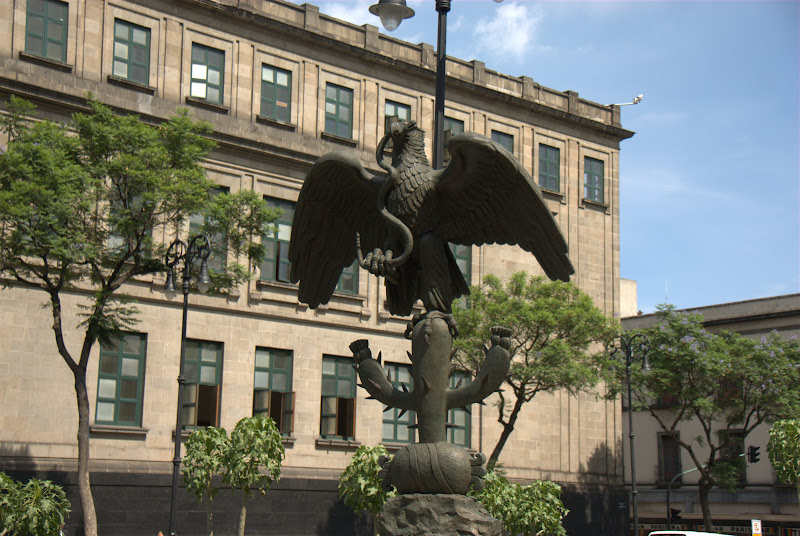
The Aztec built temples to their gods and palaces for their kings. They grew an empire and ruled a city of about 250,000 people until Cortes the conquistador came to visit in 1519. What transpired between Moctezuma and Cortes left the population depleted and the city razed to the ground.
The Spanish proceeded to build their on city on top of the remains and this is what the center looks like today.
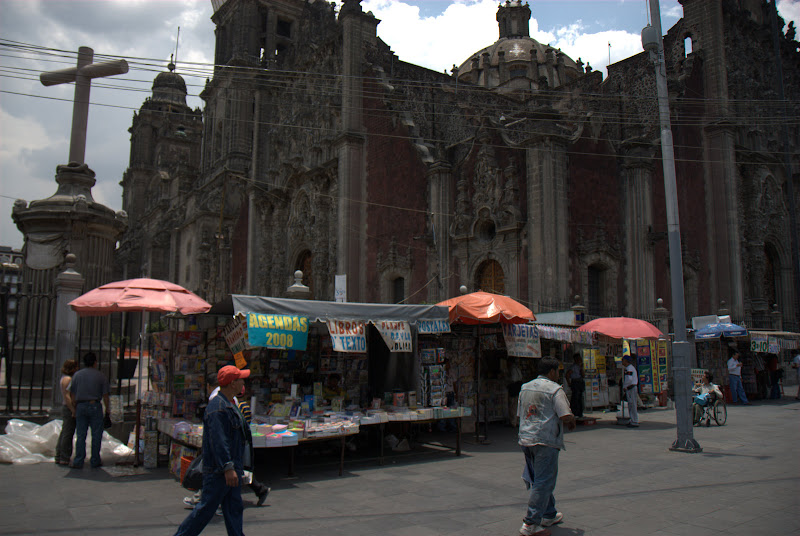
During a construction in the mid 20th century, workers came upon a large statue of a god and the authorities decided to dig. What was discovered, right next to the cathedral, were the remains of the main temple. The temple was mostly destroyed when the Spanish took over, then turned into a garbage heap. There was not much above street level, but you can see in the pictures the different phases of expansion of the temple (each king's ego begets a new wall), and some of the statues that remain from that time. The original temple had two altars at the top where human sacrifices were performed and the heart placed in this surprised guy's cup.

You can also see the shrine to the underworld, this wall of skulls.
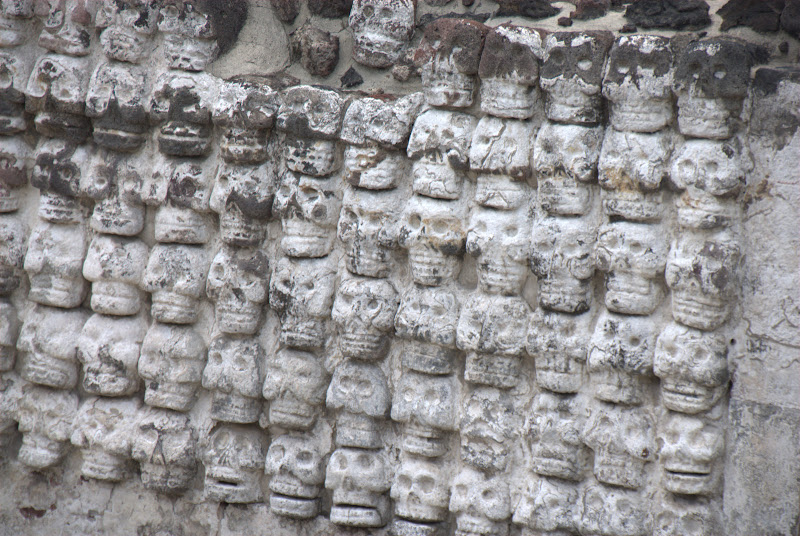
It's interesting to see the temple along side the old cathedral and the more modern building surrounding the main square.
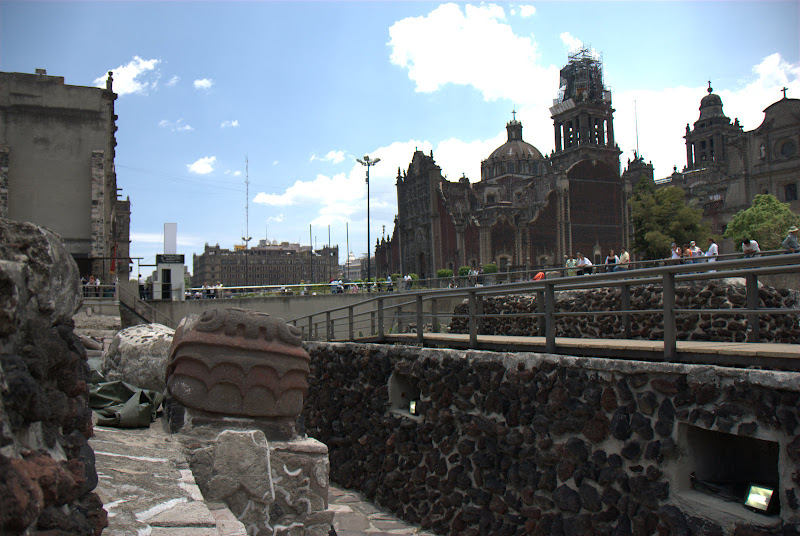
This place, according to Aztec tradition, is the center of the world. I'm intrigued at what religion doesn't believe it is situated near or at the center of the world.
Subway Etiquette
There are a number of dangers in Mexico City. Foremost is traffic - watch where you're going. Next is pick pockets looking for your spare change so always separate your daily money from your credit cards, wallet, etc. Then there's kidnapping (about 4 a day in the city). My solution: sit down if anyone tries to kidnap me and let's see what they'll do then.
Then there are the taxis. Specifically, the driver takes you somewhere where his friends jump into the cab and they rob you at gunpoint. Only take taxis recommended by establishments or ordered by phone. Except for to and from the airport, I only used the subway.
Mexico city's subway will take you all over the city with only one thing you need to worry about: Don't take line 1 east during rush hour.
A couple of years ago I was in Toronto, Canada and I took the subway during rush hour. It was winter so I was bundled in a heavy coat and had a backpack. Standing in the doorway of the cabin, I took up a good chunk of the door. When the train stopped people moved around me to get out. I had earphones on so it took me a while to realize that they were grumbling quite loudly that I should step down to let everyone out, that I was a jerk, etc., etc. But none of them asked. Not growing up near a subway it didn't even occur to me.
Now in case you ever find yourself in Mexico City, let me give you some hints on south-of-the-border subway etiquette. It took me a couple of days to undersand that being the first to stand near the door before the train stops does not guarantee being the first to get in. Reflexes and speed matter, as well as what space the people coming out of the train leave.
But when rush hour hits, and no one gets off the train, the story changes. Groups of people congregate where the door of the train will be. When the train stop, everyone starts pushing into the train, with the first people trying to push through the already sardine-packed doorway. The cabin is considered full when there's no space to move and only the people at the doorway need to hold themselves in place so that the internal pressure does not push them out. As the door closes they suck their stomachs in.
Needless to say it took me 4 trains before I managed to get on - it was a relatively empty train. I made my way to the back to have a bit of peace from all the pushing. Unfortunately at the next stop we stopped for close to 40 minutes and by then we were completely full. Or so I thought, until the next stop a couple of men got onto the train by taking a head start and jumping into the on-board crowd, forcing their way in.
Now you may think getting off is easy with all these people on board, but let me tell you, careful planning is required. As we stopped at the station I needed, I started pushing through the crowd to get out. While people will wiggle around to give you a bit of space, no one would get off the train. (They haven't met the grumbling Canadians). Add to that the stream of people pushing right back to get in and you get stalemate. After a couple of minutes of pushing, the train's doors closed and I was still 2/3 away from the door (I was standing opposite the door when we stopped). The next stop got me halfway across. By the next stop, everyone realized I was trying to exit the train. While no one would move for fear of losing their spot, they were certainly helpful. And so, as the door opened, a couple of guys behind me started pushing, helping me "fly" out of the train.
Teotihuacan
Some 1900 years ago, the ancient city of Teotihuacan was at its highest. It's unclear who built the city. It's not attributed to the Aztec nor the Toltec since both cultures came later than the city's fall. The city at its height was bigger than any european city of its time.
The city is divided into four sections by two perpendicular avenues, the longest of the two called the avenue of the dead by the Aztec, since they could not imagine how men could build such huge buildings. Instead, they assumed it was the gods who built tombs for the men of old.
The city's most impressive features are the pyramids of the Sun and the Moon, dominating the view throughout the avenue.
The pyramid of the Sun is the 3rd largest in the world, after the Egyptian Cheops pyramid and another pyramid in Mexico. It's 222m to a side, 70m high (230 feet). It was built around 100AD and if you find that amazing, consider that the local culture had no metal, no pack animals and no wheel.
What they lacked in technology, they made up for in very tall steps. And I bet you they could sprint to the top.
Interestingly enough archaeologists now think the pyramid may have been in honor of a water deity, not the Sun, due to the moat that originally surrounded it.
The smaller but more impressive is the pyramid of the moon which you can approach along the avenue of the dead. Surrounded by other temples, it looms above you as you approach.
Boats and Magic and Dolls, Oh My!
I spent one day going to markets and looking at how the locals shop. While the Merced market is huge and spans a few blocks, it is not interesting except for the puzzle it holds for the first time visitor. Once you exit the metro station, can you ever find it again? The building is not visible from outside since stalls are arrayed around it and you have to ask or guess to stumble into it.
Next to it is the magic market, or Mercado Sonora. Stalls sell many kinds of herbs and powders used in local magic. A few stalls also specialize in imported magic. Take this stall for example where you can find Christian and Jewish symbols, angel-of-death figures, baby dolls and trolls.
yes - trolls. Ugly as hell trolls. I bought 20.
I've also reaffirmed my belief that Mexican food south of the border sucks. The American version is much better, something I wouldn't say about many other americanized ethnic foods. Even following recommendations from the guide, I only found one place I'd go back to to try out other dishes. On the other hand, can you tell what's being served in this place:
To add the obligatory (and always relaxing) boat excursion to this trip, I traveled to the south of the city where what's left of the original lake can still be found. The area, called Xochimilco, is still farmed by the locals. The process involves scooping mud from the lake and concentrating it in an area that then becomes an island. The island is fenced with wire so that the mud doesn't leak out too quickly and this becomes a field.
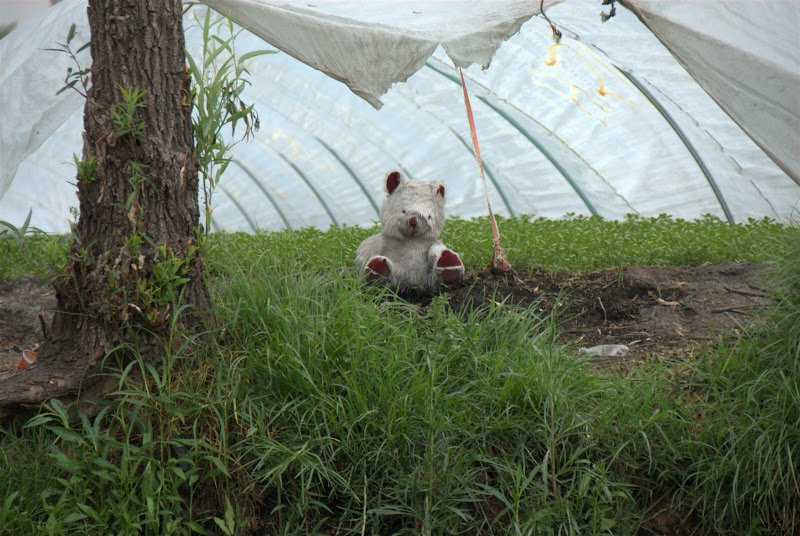
Flat boats sitting around 20 people are available for hire in the channels left by the fields. The boat has a long table, chairs, and a boatman. You bring your own food and drink and slowly float along the canals, being propelled by the boatman using a very long pole. I'm sure I didn't pay enough for the 3.5 hour ride he took me on, so I helped a bit.
Pepper and I (because I finally remembered to take pepper out of the suitcase) anxiously awaited our visit to La Isla De La Munecas [sonido del trueno], also known as The Island of the Dolls [sound of thunder].
Life comes your way on the lake, and you can find boats with food and drink and even boats where for $5 this trio will play a song for you.
But we were set on getting to The Island of the Dolls [sound of thunder]. The first glimpse of it was this vicious camouflaged guard rabbit.
And then we were there, the The Island of the Dolls [sound of thunder]. Climbing out of the boat you could feel the atmosphere getting heavy with the spirits of dolls past. Welcome to The Island of the Dolls [sound of thunder].
The island's eccentric (read screwed up in the head) owner, Don Julian, believed his island was haunted by a spirit. In order to appease it, he fished dolls out of the water and hung them on trees and in cabins throughout his island. The dolls where not maintained and the atmosphere is decidedly gruesome.
And when you step into the little cabin where the Spanish-only explanation said lots of words I didn't understand, there was Chucky, looking over his domain.
Needless to say Pepper hung out with some of the dolls before we sailed back.
Full album at:
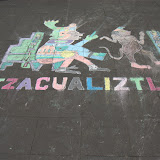 |
| MexicoCity |
Technorati Tags: Mexico, Mexico City, Teotihuacan, Aztec, Island of the Dolls, Subway, Eran Davidov